Assisting Sustainable Entrepreneurial Activities Through the Analysis of Mobile IT Services’ Success and Failure Factors
Abstract
:1. Introduction
2. Theoretical Discussion and Hypotheses
2.1. Mobile IT Services
2.2. Factors and Criteria for IT Service Success and Failure
2.2.1. Maturity of the Platform Business
2.2.2. Establishment of Interests
2.2.3. Ecosystem Establishment
2.2.4. Technical Completeness
2.2.5. Size of the Launching Enterprise
2.2.6. PC Interconnection
2.2.7. Consumer Pricing Strategies
2.2.8. Innovations in New Technology
3. Research Methodology
3.1. Research Model
3.2. IT Service Case Selection
3.3. Survey to IT Entrepreneurs
4. Empirical Analysis
4.1. Survey
4.2. Results of the t-Test
4.3. Results of Logistic Regression
4.4. Hypothesis Verification Results
5. Discussion
5.1. Conclusions and Implications
5.2. Limitations and Future Recommendations
Author Contributions
Funding
Conflicts of Interest
Appendix A
| Name | Model | Enterprise | Category | Launching | General Outline |
|---|---|---|---|---|---|
| T Map | Merchant | SK Telecom | Information | 2002 | Mobile Navigator |
| Gifticon | Two-Sided | SK Telecom | Shopping | 2014 | Real-trade Commerce Solutions |
| Naver Camera | Merchant | Naver | Life | 2015 | Smart Camera |
| Market Kurly | Two-Sided | Kurly | Shopping | 2016 | Premium Food Shopping mall |
| Moneta Card | Merchant | SK Telecom | Finance | 2011 | First Mobile Care |
| Baedal Minjok | Two-Sided | Woowa Brothers | Life | 2010 | Delivery Relay Service |
| Bank Wallet | Merchant | KHTC | Finance | 2013 | Mobile Electric Wallet |
| Blue link | Merchant | Hyundai Motors | Maintenance | 2011 | Connected Car Service |
| Beat | Merchant | Beat | Music | 2014 | Free Music Streaming Service |
| Samsung Pay | Two-Sided | Samsung electronics | Finance | 2015 | Mobile Payment |
| Golfzon | Merchant | Golfzon | Leisure | 2014 | Golf Simulator |
| Syrup Order | Two-Sided | SK Planet | Shopping | 2014 | O2O Pre-order and Pick-up |
| Socar | Merchant | Socar | Transportation | 2011 | Car Sharing |
| Wibitalk | Two-Sided | Woori Bank | Finance | 2016 | Mobile Finance Platform |
| The Pirates | Two-Sided | The Pirates | Shopping | 2013 | Fish Market Linked Market Service |
| Jeongyookgak | Merchant | Jeongyookgak | Shopping | 2016 | Livestock Distribution Start-up |
| Kakao Bank | Merchant | Kakao | Finance | 2016 | Online Bank |
| Kakao Taxi | Two-Sided | Kakao | Transportation | 2015 | Mobile call Taxi Connection Service |
| Coocha | Two-Sided | Coocha | Shopping | 2015 | Hot Deal Comparing Shopping Platform |
| Coupang | Two-Sided | Coupang | Shopping | 2013 | Distribution Specialized e-Commerce |
| T Money | Merchant | KSCC | Finance | 2003 | O2O Payment Platform |
| Hwahae | Two-Sided | Birdview | Beauty | 2013 | Cosmetic Information Service |
Appendix B
| Service | Category | Establishment of Interest | Eco System Establishment | Technical Completeness | Success/Failure |
|---|---|---|---|---|---|
| 1 (Strongly Disagree) to 7 (Strongly Agree) | |||||
| T Map | Information | ||||
| Gifticon | Shopping | ||||
| Naver Camera | Life | ||||
| Market Kurly | Shopping | ||||
| Moneta Card | Finance | ||||
| Baedal Minjok | Life | ||||
| Bank Wallet | Finance | ||||
| Blue link | Maintenance | ||||
| Beat | Music | ||||
| Samsung Pay | Finance | ||||
| Golfzon | Leisure | ||||
| Syrup Order | Shopping | ||||
| Socar | Transportation | ||||
| Wibeetalk | Finance | ||||
| The Pirates | Shopping | ||||
| Jeongyookgak | Shopping | ||||
| Kakao Bank | Finance | ||||
| Kakao Taxi | Transportation | ||||
| Coocha | Shopping | ||||
| Coupang | Information | ||||
| T Money | Shopping | ||||
| Hwahae | Beauty | ||||
Appendix C
| Service | Size of Launching Enterprise | PC Interconnection | Consumer Charging | Introduction of New Technology |
|---|---|---|---|---|
| 0 (Small) or 1 (Big) | 0 (No) or 1 (Yes) | 0 (No) or 1 (Yes) | 0 (No) or 1 (Yes) | |
| T Map | 1 | 0 | 0 | 1 |
| Gifticon | 1 | 1 | 0 | 1 |
| Naver Camera | 1 | 0 | 0 | 0 |
| Market Kurly | 0 | 1 | 0 | 1 |
| Moneta Card | 1 | 0 | 0 | 1 |
| Baedal Minjok | 0 | 1 | 0 | 1 |
| Bank Wallet | 1 | 0 | 0 | 0 |
| Blue link | 1 | 0 | 0 | 0 |
| Beat | 0 | 1 | 1 | 0 |
| Samsung Pay | 1 | 0 | 0 | 1 |
| Golfzon | 0 | 0 | 0 | 1 |
| Syrup Order | 1 | 0 | 0 | 1 |
| Socar | 0 | 1 | 0 | 0 |
| Wibeetalk | 1 | 1 | 1 | 0 |
| The Pirates | 0 | 1 | 0 | 1 |
| Jeongyookgak | 0 | 1 | 0 | 1 |
| Kakao Bank | 1 | 0 | 0 | 1 |
| Kakao Taxi | 1 | 0 | 0 | 1 |
| Coocha | 0 | 1 | 1 | 1 |
| Coupang | 0 | 1 | 0 | 1 |
| T Money | 1 | 1 | 0 | 0 |
| Hwahae | 0 | 0 | 1 | 1 |
Appendix D
References
- Jin, S.H.; Choi, S.O. The Effect of Innovation Capability on Business Performance: A Focus on IT and Business Service Companies. Sustainability 2019, 11, 5246. [Google Scholar] [CrossRef]
- Lee, K.; Park, Y.; Lee, D. Effect of the ICT ecosystem structure on the sustainable growth of ICT firms: A metafrontier analysis on China, South Korea, the United States, and Japan. Sustainability 2016, 8, 469. [Google Scholar] [CrossRef]
- Kim, H. IT Service New Paradigm. Commun. Korean Inst. Inf. Sci. Eng. 2008, 26, 76–82. [Google Scholar]
- Wang, Y.S.; Lin, H.H.; Luarn, P. Predicting consumer intention to use mobile service. Inf. Syst. J. 2006, 16, 157–179. [Google Scholar] [CrossRef]
- Statista. Worldwide Mobile App Store Revenues in 2015, 2016 and 2020 (in Billion U.S. Dollars); Statista: Hamburg, Germany, 2018. [Google Scholar]
- Yoo, S.-K.; Kim, B.-Y. A Decision-Making Model for Adopting a Cloud Computing System. Sustainability 2018, 10, 2952. [Google Scholar] [CrossRef]
- Kim, C.; Costello, F.J.; Lee, K.C. Integrating Qualitative Comparative Analysis and Support Vector Machine Methods to Reduce Passengers’ Resistance to Biometric E-Gates for Sustainable Airport Operations. Sustainability 2019, 11, 5349. [Google Scholar] [CrossRef]
- Tomy, S.; Pardede, E. From uncertainties to successful start ups: A data analytic approach to predict success in technological entrepreneurship. Sustainability 2018, 10, 602. [Google Scholar] [CrossRef]
- Yoo, J.E.; Lee, K.B.; Choi, M.K.; Cho, H.J. A Study on the Policy for ICT Ecosystem based on Changes in ICT Industry Environment. In Proceedings of the Symposium of the Korean Institute of Communications and Information Sciences, Jeju, Korea, 20–22 June 2012; pp. 55–56. [Google Scholar]
- Kang, J.-W. A Study on Validity of the Application of Horizontal Regulatory Framework-Focusing on OTT(Over-The-Top). J. Broadcast. Telecommun. Res. 2013, 85–114. Available online: http://www.riss.kr/search/detail/DetailView.do?p_mat_type=1a0202e37d52c72d&control_no=ae0d5e43e93c43a4ffe0bdc3ef48d419 (accessed on 14 October 2019).
- Hwang, S.; Jang, P.Y.; Kim, S.W.; Jung, E.Y.; Lee, J.Y.; Go, M.J. The Development Strategy for Mobile Ecosystem in Korea. Sci. Technol. Policy Inst. 2011, 1, 1–232. [Google Scholar]
- Heide, J.B.; John, G. The role of dependence balancing in safeguarding transaction-specific assets in conventional channels. J. Mark. 1988, 52, 20–35. [Google Scholar] [CrossRef]
- Brown, T.J.; Churchill, G.A., Jr.; Peter, J.P. Research note: Improving the measurement of service quality. J. Retail. 1993, 69, 127. [Google Scholar] [CrossRef]
- Gerpott, T.J.; Rams, W.; Schindler, A. Customer retention, loyalty, and satisfaction in the German mobile cellular telecommunications market. Telecommun. Policy 2001, 25, 249–269. [Google Scholar] [CrossRef]
- Loorbach, D.; van Bakel, J.C.; Whiteman, G.; Rotmans, J. Business strategies for transitions towards sustainable systems. Bus. Strategy Environ. 2010, 19, 133–146. [Google Scholar] [CrossRef]
- Christensen, C.M. Making strategy: Learning by doing. Harvard Bus. Rev. 1997, 75, 141–156. [Google Scholar]
- Gwak, J.; Kim, J.; Kahn, H. The Effects of Service Types and Service Failure on Service Recovery: Moderating Effects of Rapport. J. Product. Res. 2015, 33, 77–89. [Google Scholar]
- Ziemba, E. Synthetic Indexes for a Sustainable Information Society: Measuring ICT Adoption and Sustainability in Polish Government Units. In Information Technology for Management: Emerging Research and Applications; Springer: Berlin/Heidelberg, Germany, 2018; pp. 214–234. [Google Scholar]
- Hilty, L.M.; Aebischer, B. Ict for sustainability: An emerging research field. In ICT Innovations for Sustainability; Springer: Berlin/Heidelberg, Germany, 2015; pp. 3–36. [Google Scholar]
- Ziemba, E. Synthetic indexes for a sustainable information society: Measuring ICT adoption and sustainability in Polish enterprises. In Information Technology for Management. Ongoing Research and Development; Springer: Berlin/Heidelberg, Germany, 2017; pp. 151–169. [Google Scholar]
- Hämäläinen, T.; Wallenius, E. Case study for 3G/UMTS services and billing methods, in Teletraffic Science and Engineering. Teletraffic Sci. Eng. 2001, 4, 1201–1208. [Google Scholar]
- Minerva, R.; Bell, S. Boundary blurring between telecom and the Internet. Connect World 2010, 2, 18–19. [Google Scholar]
- Jin, D.-S. Research on Success & Failure of Platform business in perspective of multi-method research. Int. Commer. Inf. Rev. 2013, 15, 387–410. [Google Scholar]
- Park, K.-N.; Jung, G.-H.; Lee, H.-Y. Acceptance Factors of Mobile Applications: Based on the Perceived Riskand Two-Sided Network Effects. J. Internet Electron. Commer. Res. 2012, 12, 207–235. [Google Scholar]
- Eisenmann, T.; Parker, G.; Van Alstyne, M. Platform envelopment. Strateg. Manag. J. 2011, 32, 1270–1285. [Google Scholar] [CrossRef]
- Evans, P.C.; Gawer, A. The Rise of the Platform Enterprise: A Global Survey; The University of Surrey: Surrey, UK, 2016. [Google Scholar]
- Chesbrough, H. Business model innovation: It′s not just about technology anymore. Strateg. Leadersh. 2007, 35, 12–17. [Google Scholar] [CrossRef]
- Kim, H.J.; Cha, Y.S.; Kim, K.H.; Ji, H.; So, Y.; Hoon, K. Case Analysis on Platform Business Models for IT Service Planning. Korea Sci. ART Forum 2016, 25, 103–118. [Google Scholar] [CrossRef]
- Jeon, I.; Ahn, J.; Kim, D. Service Characteristics Leading to “Winner-takes-all” Phenomenon in Platform Business. Korean Inst. Ind. Eng. 2015, 33, 2659–2673. [Google Scholar]
- Yoon, C.; Lee, K.; Yoon, B.; Toulan, O. Typology and Success Factors of Collaboration for Sustainable Growth in the IT Service Industry. Sustainability 2017, 9, 2017. [Google Scholar] [CrossRef]
- Griffin, A.; Page, A.L. PDMA Success Measurement Project: Recommended Measures for Product Development Success and Failure. J. Prod. Innov. Manag. 1996, 13, 478–496. [Google Scholar] [CrossRef]
- Mishra, S.; Kim, D.; Lee, D.H. Factors affecting new product success: Cross-country comparisons. J. Prod. Innov. Manag. 1996, 13, 530–550. [Google Scholar] [CrossRef]
- Rochet, J.-C.; Tirole, J. Platform competition in two-sided markets. J. Eur. Econ. Assoc. 2003, 1, 990–1029. [Google Scholar] [CrossRef]
- Furunes, T.; Mkono, M. Service-delivery success and failure under the sharing economy. Int. J. Contemp. Hosp. Manag. 2019, 31, 3352–3370. [Google Scholar] [CrossRef]
- Aaker, D. Winning in the sharing economy: Six keys to Airbnb’s success. J. Brand Strateg. 2019, 7, 310–317. [Google Scholar]
- Kim, S.-S.; Han, K.-S.; Kim, B.-S.; Park, S.-K.; Ahn, S.-K. An Empirical Study on Users Intention to Use Mobile Applications. J. Korean Inst. Inf. Technol. 2011, 9, 213–228. [Google Scholar]
- Smedlund, A. Value cocreation in service platform business models. Serv. Sci. 2012, 4, 79–88. [Google Scholar] [CrossRef]
- Parker, G.; Van Alstyne, M.W. Information complements, substitutes, and strategic product design. In Substitutes, and Strategic Product Design; Elsevier: Amsterdam, The Netherlands, 2000. [Google Scholar]
- West, J. How open is open enough? Melding proprietary and open source platform strategies. Res. Policy 2003, 32, 1259–1285. [Google Scholar] [CrossRef]
- Boudreau, K. Opening the Platform vs. Opening the Complementary Good? The Effect on Product Innovation in Handheld Computing. 24 August 2008. Available online: https://papers.ssrn.com/sol3/papers.cfm?abstract_id=1251167 (accessed on 14 October 2019).
- Parker, G.; Van Alstyne, M. Innovation, openness, and platform control. Manag. Sci. 2017, 64, 3015–3032. [Google Scholar] [CrossRef]
- Iansiti, M.; Levien, R. The Keystone Advantage: What the New Dynamics of Business Ecosystems Mean for Strategy, Innovation, and Sustainability; Harvard Business Press: Brighton, MA, USA, 2004. [Google Scholar]
- Kim, M.; Lee, S. Mobile ecosystem 2.0: World beyond platform competition. LGERI Rep. 2011, 9, 28. [Google Scholar]
- Bell, R.M.; Koren, Y. Lessons from the Netflix prize challenge. SiGKDD Explor. 2007, 9, 75–79. [Google Scholar] [CrossRef]
- Jenner, M. Is this TVIV? On Netflix, TVIII and binge-watching. New Media Soc. 2016, 18, 257–273. [Google Scholar] [CrossRef]
- Narayanan, A.; Shmatikov, V. Robust De-Anonymization of Large Datasets (How to Break Anonymity of the Netflix Prize Dataset). 2008. Available online: https://www.cs.utexas.edu/~shmat/shmat_oak08netflix.pdf (accessed on 14 October 2019).
- Cusumano, M. Technology strategy and management the evolution of platform thinking. Commun. ACM 2010, 53, 32–34. [Google Scholar] [CrossRef]
- Song, C.; Kim, B.C.; Park, K. Impact of Consumer Rating on Mobile Application Sales: A Comparison between Korean and American Consumers. Korean Manag. Rev. 2014, 43, 1493–1518. [Google Scholar]
- Jung, W.; Lee, K.-K. The Effects of the Service Quality of Smartphone Applications on User Satisfaction and Loyalty. Soc. Korea Ind. Syst. Eng. 2013, 36, 79–86. [Google Scholar] [CrossRef]
- Chung, N.; Kwon, S.J. Effect of trust level on mobile banking satisfaction: A multi-group analysis of information system success instruments. Behav. Inf. Technol. 2009, 28, 549–562. [Google Scholar] [CrossRef]
- Al-Jabri, I.M.; Sohail, M.S. Mobile banking adoption: Application of diffusion of innovation theory. J. Electron. Commer. Res. 2012, 13, 379–391. [Google Scholar]
- Lin, H.-F. Determining the relative importance of mobile banking quality factors. Comput. Stand. Interfaces 2013, 35, 195–204. [Google Scholar] [CrossRef]
- Hofer, C.W. Toward a contingency theory of business strategy. Acad. Manag. J. 1975, 18, 784–810. [Google Scholar] [CrossRef]
- Kwon, K.-D.; Kim, J.-W. Relational Trait between Large Firm & Venture Business, Relationship of Cooperation and Venture Business Performance. Korean Acad. Assoc. Bus. Adm. 2006, 19, 2065–2091. [Google Scholar]
- Nooteboom, B. Institutions and forms of co-ordination in innovation systems. Organ. Stud. 2000, 21, 915–939. [Google Scholar] [CrossRef]
- Pagani, M. Digital business strategy and value creation: Framing the dynamic cycle of control points. MIS Q. 2013, 37, 617–632. [Google Scholar] [CrossRef]
- Amatya, S.; Kurti, A. Cross-platform mobile development: Challenges and opportunities. In Proceedings of the International Conference on ICT Innovations, Ohird, Macedonia, 5–7 September 2013; pp. 219–229. [Google Scholar]
- Jeon, J.H.; Lee, S.Y. Standardizations for Future Mobile Web Application. Electron. Telecommun. Trends 2010, 25, 100–113. [Google Scholar]
- Osterwalder, A.; Pigneur, Y. Business Model Generation: A Handbook for Visionaries, Game Changers, and Challengers; John Wiley & Sons: Hoboken, NJ, USA, 2010. [Google Scholar]
- Kim, J.; Shin, S.; Ryu, I. The Effect of User Perceived-Value on Intention to Use for Mobile Application Service. Korea Internet Electrorn. Commer. Assoc. 2013, 13, 229–255. [Google Scholar]
- Kleinschmidt, E.J.; Cooper, R.G. The impact of product innovativeness on performance. J. Prod. Innov. Manag. 1991, 8, 240–251. [Google Scholar] [CrossRef]
- Kim, W.-J.; Chung, H.-Y. A Study on the Relationship Between Entrepreneur Characteristics and the Performance of Small Firms. Asia-Pac. J. Bus. Ventur. Entrep. 2007, 2, 33–60. [Google Scholar]
- Kim, B.-S. Globalization Strategy of Korean Strong Medium Enterprises and the Role of CEO. Korean J. Bus. Adm. 2011, 24, 1539–1564. [Google Scholar]
- Data, K.E. Korea Corporate Status Information System. Available online: http://sminfo.mss.go.kr/ (accessed on 25 April 2019).
- Kang, C.; Hong, Y.S.; Kim, K.-J.; Park, K. A Relation-based Model for Analyzing Ecosystems of Products, Services and Stakeholders. J. Korean Inst. Ind. Eng. 2011, 37, 41–54. [Google Scholar] [CrossRef] [Green Version]
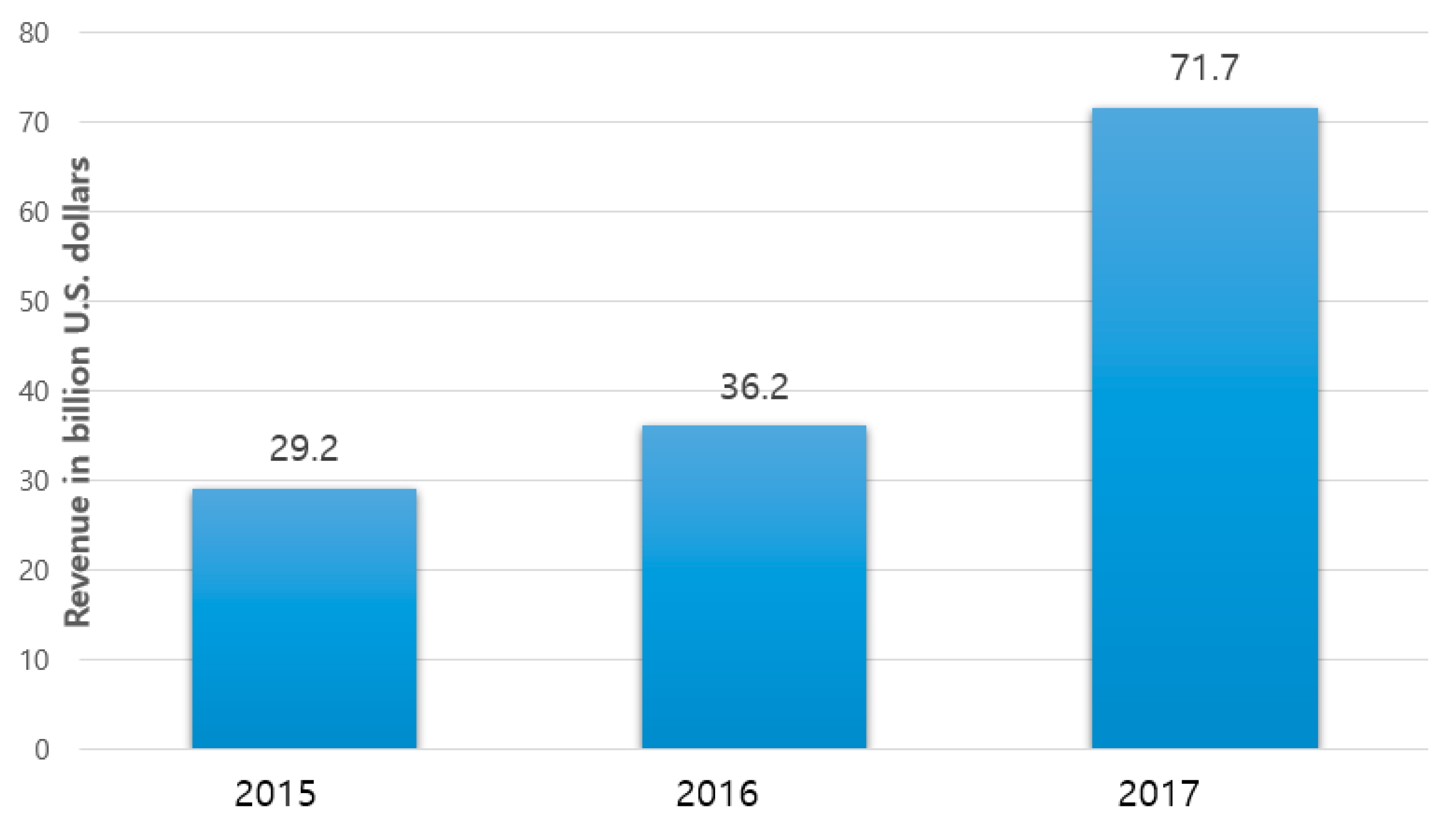
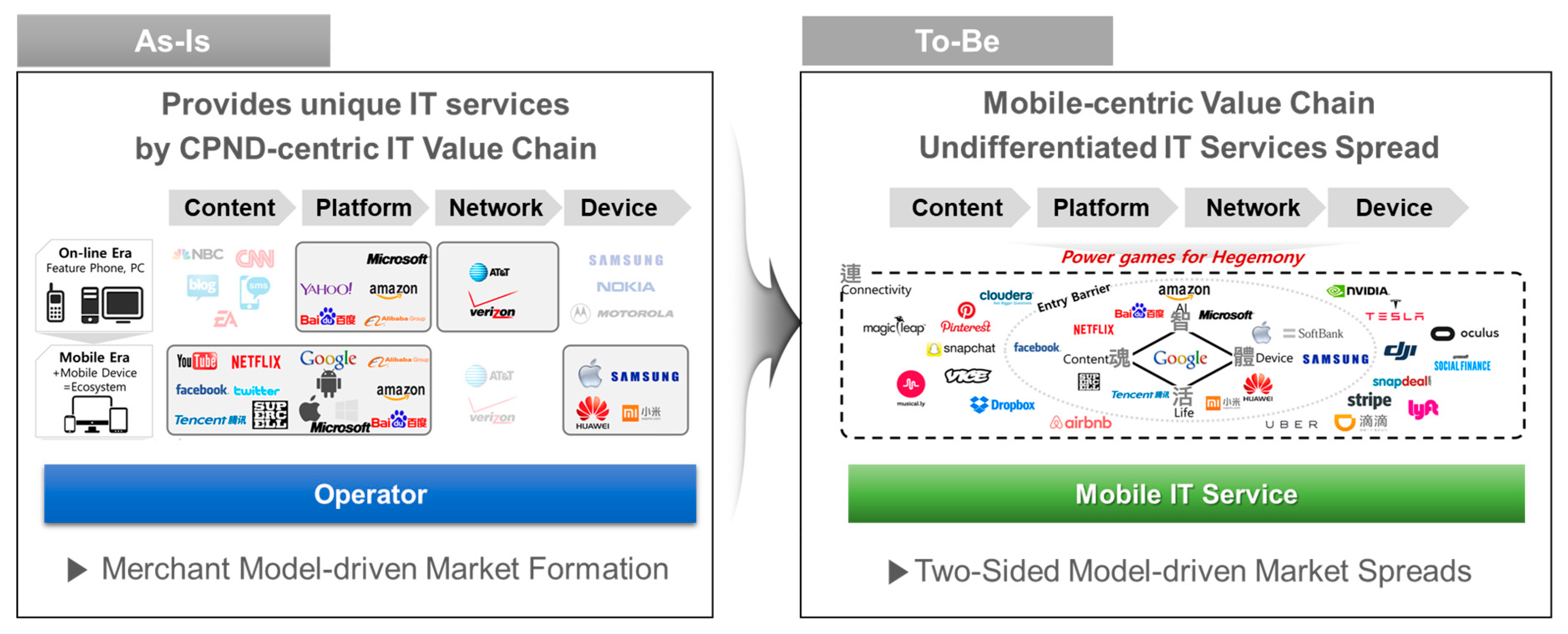
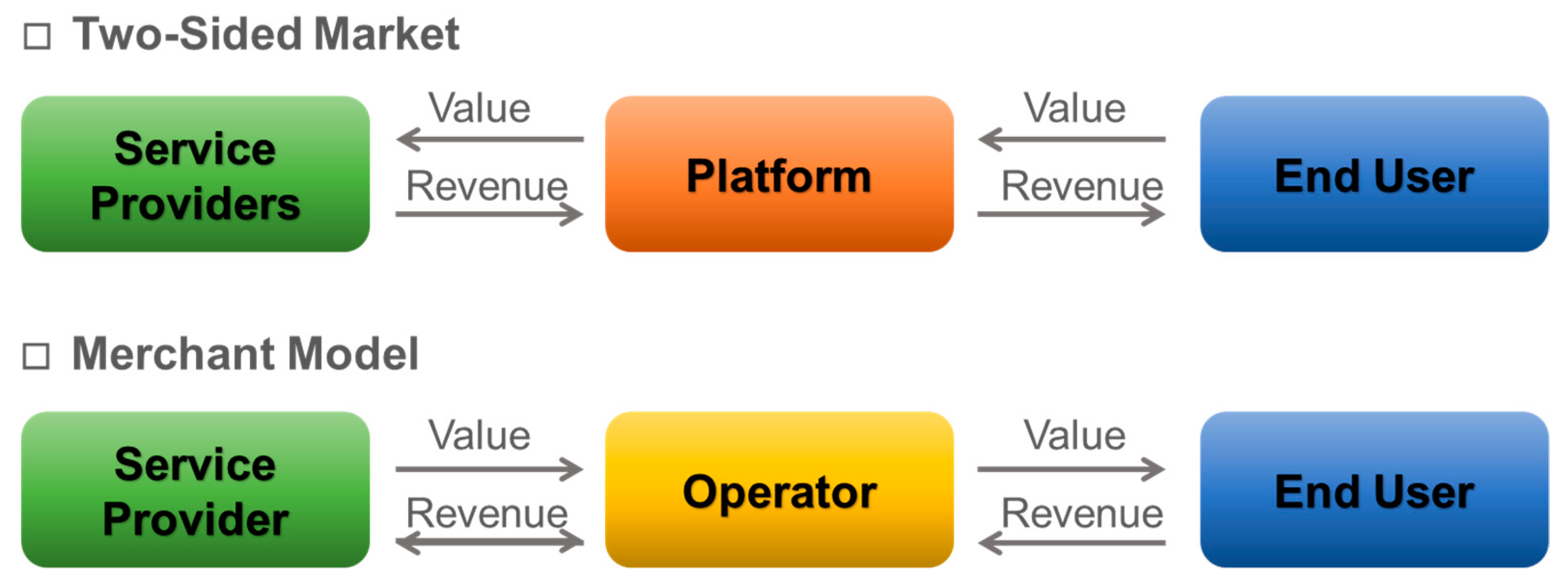
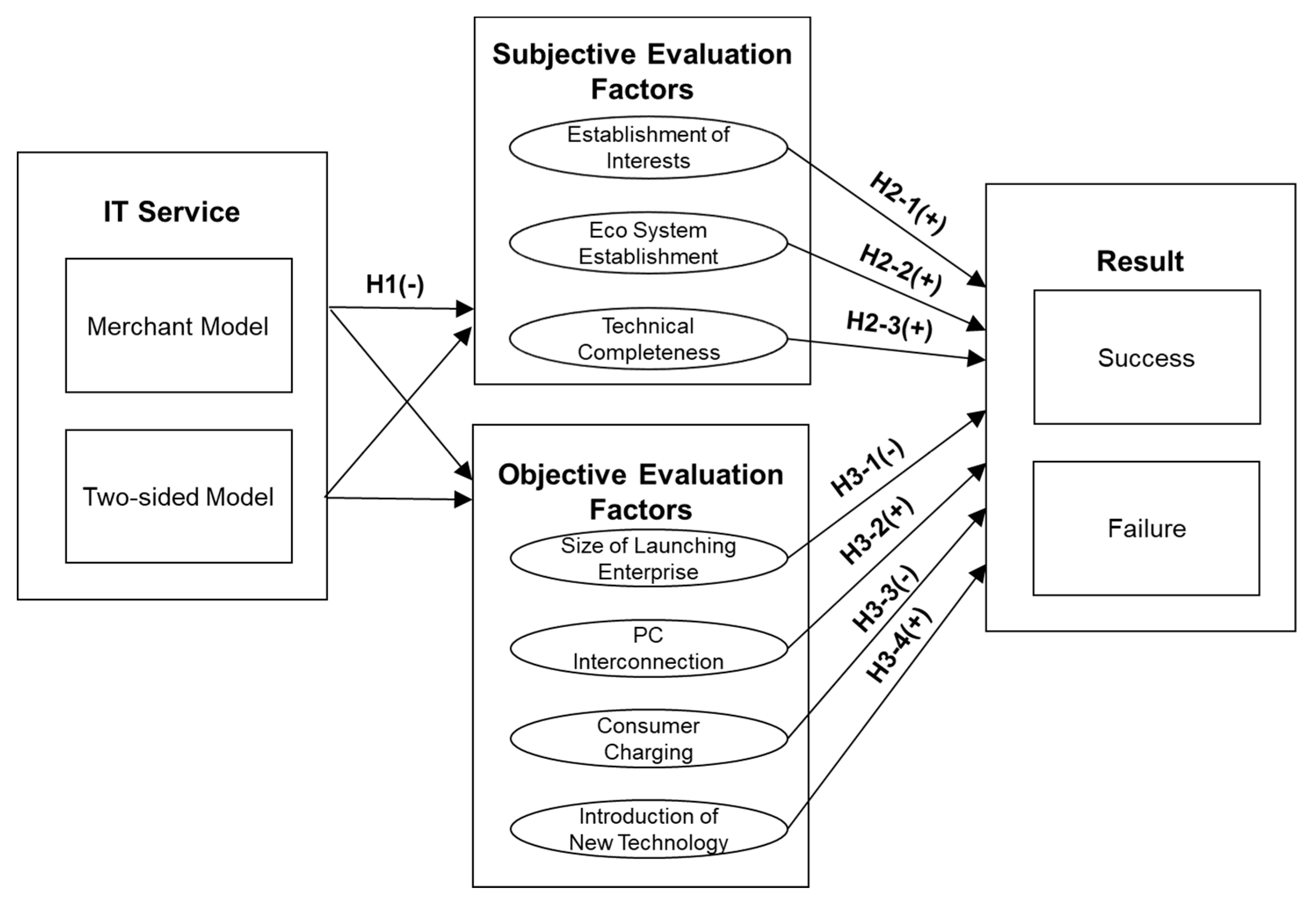
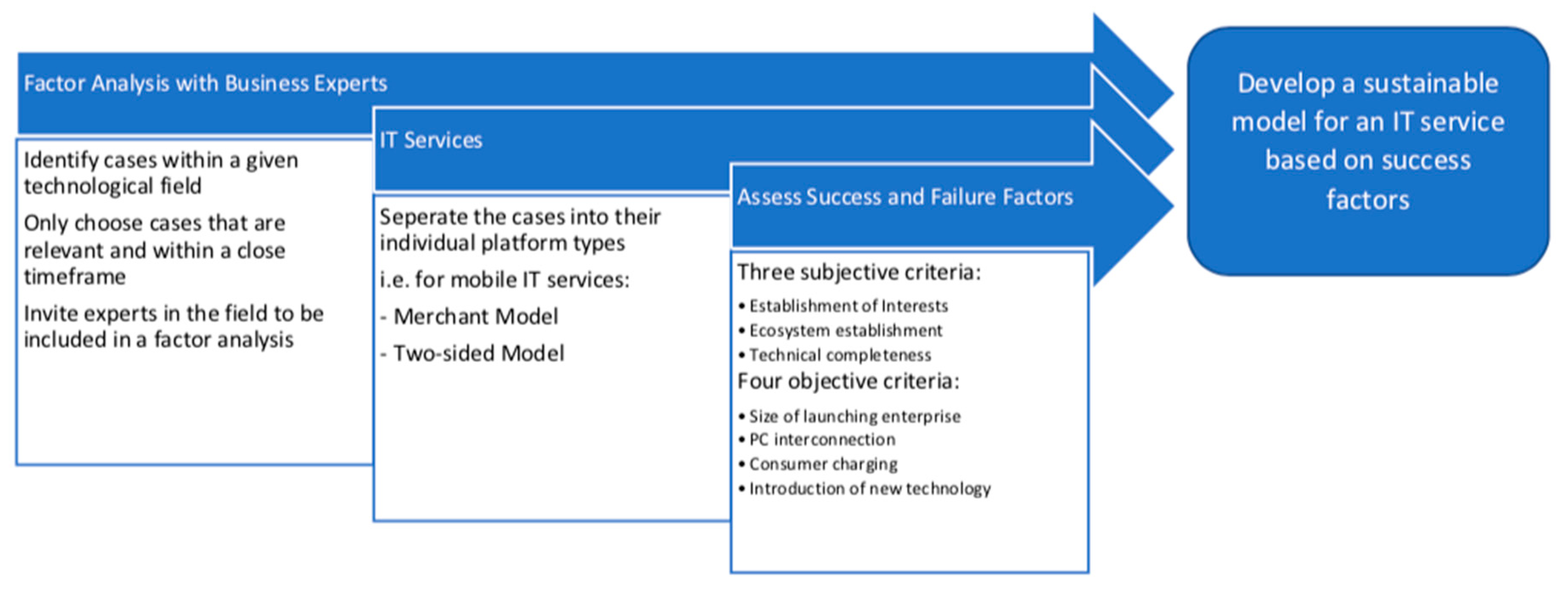
| Type | Name | Enterprise | Category | Index |
|---|---|---|---|---|
| Merchant Model | T Map | SK Telecom | Telecommunication | Information |
| Golfzon | Golfzon | Leisure | Entertainment | |
| Naver Camera | Naver | Life | Productivity | |
| Moneta Card | SK Telecom | Finance | Productivity | |
| Bank Wallet | Bank union | Finance | Productivity | |
| Bluelink | Hyundai Motors | Maintenance | Productivity | |
| Beat | Beat | Music | Entertainment | |
| Socar | Socar | Transportation | Productivity | |
| Jeongyookgak | Jeongyookgak | Shopping | Information | |
| Kakao Bank | Kakao | Finance | Productivity | |
| T Money | KSCC | Finance | Productivity | |
| Two-Sided Model | Gifticon | SK Telecom | Shopping | Productivity |
| Market Kurly | Kurly | Shopping | Information | |
| Baedal Minjok | Woowa Brothers | Life | Information | |
| Samsung Pay | Samsung Electronics | Finance | Productivity | |
| Syrup | SK Planet | Shopping | Productivity | |
| Wibee Talk | Woori Bank | Finance | Productivity | |
| The Pirates | The Pirates | Shopping | Information | |
| Kakao Taxi | Kakao | Transportation | Information | |
| Coocha | Coocha | Shopping | Information | |
| Coupang | Coupang | Shopping | Information | |
| Hwahae | Birdview | Beauty | Information |
| No. | Age | Profession | Career (years) | Location |
|---|---|---|---|---|
| 1 | 49 | Consulting | 20 | Seoul |
| 2 | 40 | Consulting | 18 | Seoul |
| 3 | 35 | Education | 8 | Seoul |
| 4 | 39 | Operation | 6 | Seoul |
| 5 | 35 | Planning | 9 | Seoul |
| 6 | 36 | Analysis | 8 | Seoul |
| 7 | 37 | Planning | 7 | Seoul |
| 8 | 31 | Planning | 7 | Gyeonggi |
| 9 | 35 | Finance | 9 | Seoul |
| 10 | 35 | Planning | 3 | Gyeonggi |
| 11 | 37 | Marketing | 11 | Seoul |
| Questionnaire | Source |
|---|---|
| Establishment of Interests | Kim et al. [36], Smedlund [37], Parker and Van Alstyne [38], West [39], Boudreau [40], Parker and Van Alstyne [41] |
| Ecosystem Establishment | Iansiti and Levien [42], Kim and Lee [43], Bell and Koren [44], Jenner [45], Narayanan and Shmatikov [46] |
| Technical Completeness | Song et al. [48], Jung and Lee [49], Chung and Kwon [50], Al-Jabri and Sohail [51], Lin [52] |
| Category | N | Min. | Max. | Mean | SD | Skewness | Kurtosis |
|---|---|---|---|---|---|---|---|
| Establishment of Interests | 242 | 1 | 7 | 4.541 | 1.7759 | −0.154 | −1.04 |
| Ecosystem Establishment | 242 | 1 | 7 | 4.533 | 1.8085 | −0.16 | −1.115 |
| Technical Completeness | 242 | 1 | 7 | 4.744 | 1.6575 | −0.286 | −0.825 |
| Category | Mean | SD | F | ||
|---|---|---|---|---|---|
| Success | Failure | Success | Failure | ||
| Establishment of Interests | 5.504 | 3.198 | 1.3073 | 1.4424 | −12.746 * |
| Ecosystem Establishment | 5.723 | 2.871 | 1.1026 | 1.1804 | −19.049 * |
| Technical Completeness | 5.574 | 3.584 | 1.1846 | 1.5249 | −10.960 * |
| Category | Mean | SD | F | ||
|---|---|---|---|---|---|
| Success | Failure | Success | Failure | ||
| Establishment of Interests | 5.514 | 3.020 | 1.3593 | 1.4898 | −9.435 * |
| Ecosystem Establishment | 5.700 | 2.784 | 1.1715 | 1.2380 | −13.084 * |
| Technical Completeness | 5.543 | 3.765 | 1.2294 | 1.6922 | −6.420 * |
| Category | Mean | SD | F | ||
|---|---|---|---|---|---|
| Success | Failure | Success | Failure | ||
| Establishment of Interests | 5.493 | 3.380 | 1.2635 | 1.3834 | −8.572 * |
| Ecosystem Establishment | 5.746 | 2.960 | 1.0381 | 1.1241 | −13.854 * |
| Technical Completeness | 5.606 | 3.400 | 1.1769 | 1.3248 | −9.438 * |
| Category | 1 | 2 | 3 | 4 | 5 | 6 | 7 | 8 | 9 | 10 | |
|---|---|---|---|---|---|---|---|---|---|---|---|
| 1. Success Status | 1 | ||||||||||
| 2. Platform Status | 0.008 | 1 | |||||||||
| Subjective Evaluation Factors | 3. Establishment of Interests | 0.642 ** | 0.044 | 1 | |||||||
| 4. Ecosystem Establishment | 0.779 ** | 0.034 | 0.795 ** | 1 | |||||||
| 5. Technical Completeness | 0.593 ** | −0.030 | 0.601 ** | 0.663 ** | 1 | ||||||
| Objective Evaluation Factors | 6. In-App Purchase | −0.253 ** | 0.236 ** | −0.204 ** | −0.305 ** | −0.212 ** | 1 | ||||
| 7. Payment Paid | 0.002 | −0.183 ** | 0.012 | 0.044 | −0.091 | −0.516 ** | 1 | ||||
| 8. PC Interconnection | 0.109 | 0.273 ** | 0.054 | 0.089 | −0.040 | 0.236 ** | 0.000 | 1 | |||
| 9. Venture Status | −0.150 * | −0.183 ** | −0.044 | −0.121 | 0.014 | −0.280 ** | 0.083 | −0.548 ** | 1 | ||
| 10. New Technology Leaderships | 0.267 ** | 0.488 ** | 0.219 ** | 0.271 ** | 0.141 * | −0.184 ** | −0.036 | −0.098 | −0.232 ** | 1 | |
| Category | B | S.E. | Wald | P | Exp(B) | 95.0% C.I. for EXP(B) | |
|---|---|---|---|---|---|---|---|
| Lower | Upper | ||||||
| Ecosystem Establishment | 1.802 | 0.274 | 43.293 | 0.000 *** | 6.059 | 3.543 | 10.362 |
| Technical Completeness | 0.703 | 0.243 | 8.377 | 0.004 *** | 2.02 | 1.255 | 3.252 |
| Constant | 10.622 | 1.693 | 39.375 | 0 | 0 | ||
| Category | B | S.E. | Wald | P | Exp(B) | 95.0% C.I. for EXP(B) | |
|---|---|---|---|---|---|---|---|
| Lower | Upper | ||||||
| Ecosystem Establishment | 1.619 | 0.429 | 14.259 | 0.000 *** | 5.05 | 2.179 | 11.705 |
| Technical Completeness | 0.762 | 0.371 | 4.227 | 0.040 ** | 2.143 | 1.036 | 4.434 |
| PC Interconnection | 3.756 | 1.171 | 10.281 | 0.001 *** | 42.773 | 4.306 | 424.863 |
| New Technology Leadership | 1.908 | 0.903 | 4.465 | 0.035 ** | 6.738 | 1.148 | 39.546 |
| Constant | −12.042 | 2.835 | 18.048 | 0 | 0 | ||
| Category | B | S.E. | Wald | P | Exp(B) | 95.0% C.I. for EXP(B) | |
|---|---|---|---|---|---|---|---|
| Lower | Upper | ||||||
| Ecosystem Establishment | 1.934 | 0.431 | 20.11 | 0.000 *** | 6.919 | 2.971 | 16.114 |
| Technical Completeness | 0.935 | 0.426 | 4.821 | 0.028 ** | 2.546 | 1.106 | 5.864 |
| Constant | −12.328 | 2.829 | 18.996 | 0.000 *** | 0 | ||
| Hypothesis | Keyword | Service Total | Merchant Model | Two-Sided Model | |
|---|---|---|---|---|---|
| H1 | The success factors of mobile IT services are affected by the level of maturity of the platform business that connects service providers and users. | Maturity of the Platform Business | Reject | - | - |
| H2-1 | Differentiating from services launched in the existing market has a positive impact on the success of mobile IT services. | Establishment of Interests | Reject | Reject | Reject |
| H2-2 | Providers offering borderless services through the ecosystem with various channels will have a positive impact on the success of mobile IT services. | Ecosystem Establishment | Accept | Accept | Accept |
| H2-3 | Technical completeness will have a positive impact on the success of mobile IT services. | Technical Completeness | Accept | Accept | Accept |
| H3-1 | The development and rollout of mobile IT services by small and medium venture firms have a negative impact on success. | Venture Launching | Reject | Accept | Reject |
| H3-2 | Providing expanded services in conjunction with PC will have a positive impact on the success of mobile IT services. | PC Interconnection | Reject | Accept | Reject |
| H3-3 | Paid services for users will have a negative impact on the success of mobile IT services. | Consumer Charging | Reject | Reject | Reject |
| H3-4 | Leading the market by introducing new technologies with a first mover propensity will have a positive impact on the success of mobile IT services. | New Technology Leadership | Reject | Reject | Reject |
© 2019 by the authors. Licensee MDPI, Basel, Switzerland. This article is an open access article distributed under the terms and conditions of the Creative Commons Attribution (CC BY) license (http://creativecommons.org/licenses/by/4.0/).
Share and Cite
Yoon, C.H.; Costello, F.J.; Kim, C. Assisting Sustainable Entrepreneurial Activities Through the Analysis of Mobile IT Services’ Success and Failure Factors. Sustainability 2019, 11, 5694. https://doi.org/10.3390/su11205694
Yoon CH, Costello FJ, Kim C. Assisting Sustainable Entrepreneurial Activities Through the Analysis of Mobile IT Services’ Success and Failure Factors. Sustainability. 2019; 11(20):5694. https://doi.org/10.3390/su11205694
Chicago/Turabian StyleYoon, Chang Hee, Francis Joseph Costello, and Cheong Kim. 2019. "Assisting Sustainable Entrepreneurial Activities Through the Analysis of Mobile IT Services’ Success and Failure Factors" Sustainability 11, no. 20: 5694. https://doi.org/10.3390/su11205694
APA StyleYoon, C. H., Costello, F. J., & Kim, C. (2019). Assisting Sustainable Entrepreneurial Activities Through the Analysis of Mobile IT Services’ Success and Failure Factors. Sustainability, 11(20), 5694. https://doi.org/10.3390/su11205694





